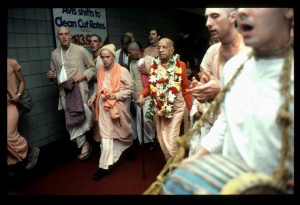CC Madhya 8.56: Difference between revisions
m (1 revision(s)) |
(Vanibot #0054 edit - transform synonyms into clickable links, which search similar occurrences) |
||
| (One intermediate revision by one other user not shown) | |||
| Line 1: | Line 1: | ||
{{ | [[Category:Sri Caitanya-caritamrta - Madhya-lila Chapter 08|C056]] | ||
<div style="float:left">'''[[Sri Caitanya-caritamrta|Śrī Caitanya-caritāmṛta]] - [[CC Madhya|Madhya-līlā]] - [[CC Madhya 8|Chapter 8: Talks Between Śrī Caitanya Mahāprabhu and Rāmānanda Rāya]]'''</div> | |||
<div style="float:right">[[File:Go-previous.png|link=CC Madhya 8.55|Madhya-līlā 8.55]] '''[[CC Madhya 8.55|Madhya-līlā 8.55]] - [[CC Madhya 8.57|Madhya-līlā 8.57]]''' [[File:Go-next.png|link=CC Madhya 8.57|Madhya-līlā 8.57]]</div> | |||
{{CompareVersions|CC|Madhya 8.56|CC 1975|CC 1996}} | |||
{{RandomImage}} | |||
==== TEXT 56 ==== | ==== TEXT 56 ==== | ||
<div | <div class="verse"> | ||
namaskāra kaila rāya, prabhu kaila āliṅgane | :namaskāra kaila rāya, prabhu kaila āliṅgane | ||
dui jane kṛṣṇa-kathā kaya rahaḥ-sthāne | :dui jane kṛṣṇa-kathā kaya rahaḥ-sthāne | ||
</div> | </div> | ||
| Line 12: | Line 16: | ||
==== SYNONYMS ==== | ==== SYNONYMS ==== | ||
<div | <div class="synonyms"> | ||
''[//vanipedia.org/wiki/Special:VaniSearch?s=namaskāra&tab=syno_o&ds=1 namaskāra]'' — obeisances; ''[//vanipedia.org/wiki/Special:VaniSearch?s=kaila&tab=syno_o&ds=1 kaila]'' — offered; ''[//vanipedia.org/wiki/Special:VaniSearch?s=rāya&tab=syno_o&ds=1 rāya]'' — Rāmānanda Rāya; ''[//vanipedia.org/wiki/Special:VaniSearch?s=prabhu&tab=syno_o&ds=1 prabhu]'' — Lord Śrī Caitanya Mahāprabhu; ''[//vanipedia.org/wiki/Special:VaniSearch?s=kaila&tab=syno_o&ds=1 kaila]'' — did; ''[//vanipedia.org/wiki/Special:VaniSearch?s=āliṅgane&tab=syno_o&ds=1 āliṅgane]'' — embracing; ''[//vanipedia.org/wiki/Special:VaniSearch?s=dui&tab=syno_o&ds=1 dui]'' — two; ''[//vanipedia.org/wiki/Special:VaniSearch?s=jane&tab=syno_o&ds=1 jane]'' — the persons; ''[//vanipedia.org/wiki/Special:VaniSearch?s=kṛṣṇa&tab=syno_o&ds=1 kṛṣṇa]-[//vanipedia.org/wiki/Special:VaniSearch?s=kathā&tab=syno_o&ds=1 kathā]'' — talks about Kṛṣṇa; ''[//vanipedia.org/wiki/Special:VaniSearch?s=kaya&tab=syno_o&ds=1 kaya]'' — discussed; ''[//vanipedia.org/wiki/Special:VaniSearch?s=rahaḥ&tab=syno_o&ds=1 rahaḥ]-[//vanipedia.org/wiki/Special:VaniSearch?s=sthāne&tab=syno_o&ds=1 sthāne]'' — in a secluded place. | |||
</div> | </div> | ||
| Line 19: | Line 23: | ||
==== TRANSLATION ==== | ==== TRANSLATION ==== | ||
<div | <div class="translation"> | ||
Rāmānanda Rāya approached Lord Śrī Caitanya and offered his respectful obeisances, and the Lord embraced him. Then they began to discuss Kṛṣṇa in a secluded place. | Rāmānanda Rāya approached Lord Śrī Caitanya and offered his respectful obeisances, and the Lord embraced him. Then they began to discuss Kṛṣṇa in a secluded place. | ||
</div> | </div> | ||
| Line 26: | Line 30: | ||
==== PURPORT ==== | ==== PURPORT ==== | ||
<div | <div class="purport"> | ||
The word rahaḥ-sthāne, “in a secluded place,” is very significant. Talks about Kṛṣṇa and His pastimes—especially His pastimes in Vṛndāvana and His dealings with the | The word ''rahaḥ-sthāne'', “in a secluded place,” is very significant. Talks about Kṛṣṇa and His pastimes—especially His pastimes in Vṛndāvana and His dealings with the ''gopīs''—are all very confidential. They are not subject matter for public discussion because those who have no understanding of the transcendental nature of Kṛṣṇa’s pastimes always commit great offenses, thinking Kṛṣṇa to be an ordinary human being and the ''gopīs'' ordinary girls. Following the principle of Lord Śrī Caitanya Mahāprabhu, who never discussed the dealings between Kṛṣṇa and the ''gopīs'' publicly, devotees in the Kṛṣṇa consciousness movement are enjoined not to discuss the pastimes of Lord Kṛṣṇa in Vṛndāvana in public. For the general public, ''saṅkīrtana'' is the most effective method to awaken Kṛṣṇa consciousness. If possible, one should discuss the principles enunciated in the [[Bhagavad-gita As It Is (1972)|''Bhagavad-gītā'']]. Śrī Caitanya Mahāprabhu followed this principle very strictly and discussed the philosophy of the [[Bhagavad-gita As It Is (1972)|''Bhagavad-gītā'']] with learned scholars like Sārvabhauma Bhaṭṭācārya and Prakāśānanda Sarasvatī. However, He taught the principles of the ''bhakti'' cult to students like Sanātana Gosvāmī and Rūpa Gosvāmī, and He discussed with Śrī Rāmānanda Rāya the topmost devotional dealings between Kṛṣṇa and the ''gopīs''. For the general populace, He performed ''saṅkīrtana'' very vigorously. We must also follow these principles in preaching Kṛṣṇa consciousness all over the world. | ||
</div> | </div> | ||
__NOTOC__ | |||
<div style="float:right; clear:both;">[[File:Go-previous.png|link=CC Madhya 8.55|Madhya-līlā 8.55]] '''[[CC Madhya 8.55|Madhya-līlā 8.55]] - [[CC Madhya 8.57|Madhya-līlā 8.57]]''' [[File:Go-next.png|link=CC Madhya 8.57|Madhya-līlā 8.57]]</div> | |||
__NOTOC__ | |||
__NOEDITSECTION__ | |||
Latest revision as of 23:59, 19 February 2024

A.C. Bhaktivedanta Swami Prabhupada
TEXT 56
- namaskāra kaila rāya, prabhu kaila āliṅgane
- dui jane kṛṣṇa-kathā kaya rahaḥ-sthāne
SYNONYMS
namaskāra — obeisances; kaila — offered; rāya — Rāmānanda Rāya; prabhu — Lord Śrī Caitanya Mahāprabhu; kaila — did; āliṅgane — embracing; dui — two; jane — the persons; kṛṣṇa-kathā — talks about Kṛṣṇa; kaya — discussed; rahaḥ-sthāne — in a secluded place.
TRANSLATION
Rāmānanda Rāya approached Lord Śrī Caitanya and offered his respectful obeisances, and the Lord embraced him. Then they began to discuss Kṛṣṇa in a secluded place.
PURPORT
The word rahaḥ-sthāne, “in a secluded place,” is very significant. Talks about Kṛṣṇa and His pastimes—especially His pastimes in Vṛndāvana and His dealings with the gopīs—are all very confidential. They are not subject matter for public discussion because those who have no understanding of the transcendental nature of Kṛṣṇa’s pastimes always commit great offenses, thinking Kṛṣṇa to be an ordinary human being and the gopīs ordinary girls. Following the principle of Lord Śrī Caitanya Mahāprabhu, who never discussed the dealings between Kṛṣṇa and the gopīs publicly, devotees in the Kṛṣṇa consciousness movement are enjoined not to discuss the pastimes of Lord Kṛṣṇa in Vṛndāvana in public. For the general public, saṅkīrtana is the most effective method to awaken Kṛṣṇa consciousness. If possible, one should discuss the principles enunciated in the Bhagavad-gītā. Śrī Caitanya Mahāprabhu followed this principle very strictly and discussed the philosophy of the Bhagavad-gītā with learned scholars like Sārvabhauma Bhaṭṭācārya and Prakāśānanda Sarasvatī. However, He taught the principles of the bhakti cult to students like Sanātana Gosvāmī and Rūpa Gosvāmī, and He discussed with Śrī Rāmānanda Rāya the topmost devotional dealings between Kṛṣṇa and the gopīs. For the general populace, He performed saṅkīrtana very vigorously. We must also follow these principles in preaching Kṛṣṇa consciousness all over the world.